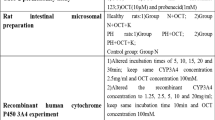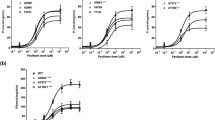Abstract
Purpose. It has been shown that plasma concentration and urinary excretion of bile acids is elevated under the cholestatic/hyperbilirubinemic conditions. Previously, it was demonstrated that the plasma concentration of bile acids was elevated in the multidrug resistance-associated protein 2 (Mrp2)-deficient rats. The purpose of the present study was to compare the sinusoidal efflux clearance of taurocholate (TC) between Mrp2-deficient Eisai hyperbilirubinemic rats (EHBR) and normal rats.
Method. Hepatic disposition of the [3H]TC was examined in the perfused liver. Apparent efflux clearance (PSnet, eff) of [3H]TC from hepatocytes to outflow across the sinusoidal membrane was defined as the amount of [3H]TC excreted into the outflow from the liver divided by hepatic AUC of [3H]TC. Additionally, influx clearance (PSinf) was also determined by multiple indicator dilution method because PSnet, eff is also affected by PSinf.
Results. PSnet, eff was significantly higher in EHBR than that in Sprague-Dawley (SD) rats (16.6 ±1.7 vs. 6.1 ± 1.3 μL/min/g liver, P <0.01). In contrast, PSinf was comparable between SD rats and EHBR. Kinetic analysis suggested that the intrinsic clearance for the efflux of [3H]TC across the sinusoidal membrane in EHBR was higher than that in SD rats (10.4 ± 1.0 v.s. 23.3 ± 1.7 μL/min/g liver, P <0.01).
Conclusions. Enhanced sinusoidal efflux of TC in EHBR may be related to the altered disposition of bile acids in the mutant rats. Because Mrp3 transports TC and its expression is induced on the basolateral membrane of Mrp2-deficient rats, the enhanced sinusoidal efflux of TC in EHBR may be accounted for, at least partially, by the increased expression of Mrp3.
Similar content being viewed by others
REFERENCES
H. Takikawa, H. Otsuka, T. Beppu, Y. Seyama, and T. Yamakawa. Serum concentrations of bile acid glucuronides in hepatobiliary diseases. Digestion 27:189-195 (1983).
T. Kinugasa, K. Uchida, M. Kadowaki, H. Takase, Y. Nomura, and Y. Saito. Effect of bile duct ligation on bile acid metabolism in rats. J. Lipid Res. 22:201-207 (1981).
H. Takikawa, N. Sano, T. Narita, Y. Uchida, M. Yamanaka, T. Horie, T. Mikami, and O. Tagaya. Biliary excretion of bile acid conjugates in a hyperbilirubinemic mutant Sprague-Dawley rat. Hepatology 14:352-360 (1991).
F. Kuipers, M. Enserink, R. Havinga, A. B. van der Steen, M. J. Hardonk, J. Fevery, and R. J. Vonk. Separate transport systems for biliary secretion of sulfated and unsulfated bile acids in the rat. J. Clin. Invest. 81:1593-1599 (1988).
R. P. Oude Elferink, D. K. Meijer, F. Kuipers, P. L. Jansen, A. K. Groen, and G. M. Groothuis. Hepatobiliary secretion of organic compounds; molecular mechanisms of membrane transport. Biochim. Biophys. Acta. 1241:215-268 (1995).
J. König, A. T. Nies, Y. Cui, I. Leier, and D. Keppler. Conjugate export pumps of the multidrug resistance protein (MRP) family: Localization, substrate specificity, and MRP2-mediated drug resistance. Biochim. Biophys. Acta. 1461:377-394 (1999).
H. Suzuki and Y. Sugiyama. Excretion of GSSG and glutathione conjugates mediated by MRP1 and cMOAT/MRP2. Semin. Liver Dis. 18:359-376 (1998).
B. Hagenbuch, B. Stieger, M. Foguet, H. Lubbert, and P. J. Meier. Functional expression cloning and characterization of the hepatocyte Na+/bile acid cotransport system. Proc. Natl. Acad. Sci. USA 88:10629-10633 (1991).
B. Hagenbuch and P. J. Meier. Molecular cloning, chromosomal localization, and functional characterization of a human liver Na+/bile acid cotransporter. J. Clin. Invest. 93:1326-1331 (1994).
P. J. Meier, U. Eckhardt, A. Schroeder, B. Hagenbuch, and B. Stieger. Substrate specificity of sinusoidal bile acid and organic anion uptake systems in rat and human liver. Hepatology 26:1667-1677 (1997).
C. Reichel, B. Gao, J. Van Montfoort, V. Cattori, C. Rahner, B. Hagenbuch, B. Stieger, T. Kamisako, and P. J. Meier. Localization and function of the organic anion-transporting polypeptide Oatp2 in rat liver. Gastroenterology 117:688-695 (1999).
J. König, Y. Cui, A. T. Nies, and D. Keppler. A novel human organic anion transporting polypeptide localized to the basolateral hepatocyte membrane. Am. J. Physiol. Gastrointest. Liver Physiol. 278:G156-G164 (2000).
I. Tamai, J. Nezu, H. Uchino, Y. Sai, A. Oku, M. Shimane, and A. Tsuji. Molecular identification and characterization of novel members of the human organic anion transporter (OATP) family. Biochem. Biophys. Res. Commun. 273:251-260 (2000).
H. Akita, H. Suzuki, K. Ito, S. Kinoshita, N. Sato, H. Takikawa, and Y. Sugiyama. Characterization of bile acid transport mediated by multidrug resistance associated protein 2 and bile salt export pump. Biochim. Biophys. Acta. 1511:7-16 (2001).
T. Gerloff, B. Stieger, B. Hagenbuch, J. Madon, L. Landmann, J. Roth, A. F. Hofmann, and P. J. Meier. The sister of P-glycoprotein represents the canalicular bile salt export pump of mammalian liver. J. Biol. Chem. 273:10046-10050 (1998).
B. Stieger, K. Fattinger, J. Madon, G. A. Kullak-Ublick, and P. J. Meier. Drug-and estrogen-induced cholestasis through inhibition of the hepatocellular bile salt export pump (Bsep) of rat liver. Gastroenterology 118:422-430 (2000).
T. Hirohashi, H. Suzuki, K. Ito, K. Ogawa, K. Kume, T. Shimizu, and Y. Sugiyama. Hepatic expression of multidrug resistance-associated protein-like proteins maintained in eisai hyperbilirubinemic rats. Mol. Pharmacol. 53:1068-1075 (1998).
K. Ogawa, H. Suzuki, T. Hirohashi, T. Ishikawa, P. J. Meier, K. Hirose, T. Akizawa, M. Yoshioka, and Y. Sugiyama. Characterization of inducible nature of MRP3 in rat liver. Am. J. Physiol. Gastrointest. Liver Physiol. 278:G438-G446 (2000).
M. Kool, M. van der Linden, M. de Haas, G. L. Scheffer, J. M. de Vree, A. J. Smith, G. Jansen, G. J. Peters, N. Ponne, R. J. Scheper, R. P. Elferink, F. Baas, and P. Borst. MRP3, an organic anion transporter able to transport anti-cancer drugs. Proc. Natl. Acad. Sci. USA 96:6914-6919 (1999).
J. König, D. Rost, Y. Cui, and D. Keppler. Characterization of the human multidrug resistance protein isoform MRP3 localized to the basolateral hepatocyte membrane. J. Biol. Chem. 274:15181-15185 (1999).
T. Hirohashi, H. Suzuki, and Y. Sugiyama. Characterization of the transport properties of cloned rat multidrug resistance-associated protein 3 (MRP3). J. Biol. Chem. 274:15181-15185 (1999).
T. Hirohashi, H. Suzuki, H. Takikawa, and Y. Sugiyama. ATP-dependent transport of bile salts by rat multidrug resistance-associated protein 3 (Mrp3). J. Biol. Chem. 275:2905-2910 (2000).
E. Jacquemin, B. Hagenbuch, B. Stieger, A. W. Wolkoff, and P. J. Meier. Expression cloning of a rat liver Na(+)-independent organic anion transporter. Proc. Natl. Acad. Sci. USA 91:133-137 (1994).
B. Stieger, B. Hagenbuch, L. Landmann, M. Hochli, A. Schroeder, and P. J. Meier. In situ localization of the hepatocytic Na+/Taurocholate cotransporting polypeptide in rat liver. Gastroenterology 107:1781-1787 (1994).
H. Sato, Y. Sugiyama, Y. Sawada, T. Iga, S. Sakamoto, T. Fuwa, and M. Hanano. Dynamic determination of kinetic parameters for the interaction between polypeptide hormones and cell-surface receptors in the perfused rat liver by the multiple-indicator dilution method. Proc. Natl. Acad. Sci. USA 85:8355-8359 (1988).
S. Miyauchi, Y. Sawada, T. Iga, M. Hanano, and Y. Sugiyama. The influence of glucagon on the hepatic transport of taurocholate in isolated perfused rat liver: Kinetic analysis by the multiple indicator dilution technique. Biol. Pharm. Bull. 16:791-795 (1993).
P. L. Jansen, G. M. Groothuis, W. H. Peters, and D. F. Meijer. Selective hepatobiliary transport defect for organic anions and neutral steroids in mutant rats with hereditary-conjugated hyperbilirubinemia. Hepatology 7:71-76 (1987).
O. Takenaka, T. Horie, K. Kobayashi, H. Suzuki, and Y. Sugiyama. Kinetic analysis of hepatobiliary transport for conjugated metabolites in the perfused liver of mutant rats (EHBR) with hereditary conjugated hyperbilirubinemia. Pharm. Res. 12:1746-1755 (1995).
H. Xiong, K. C. Turner, E. S. Ward, P. L. Jansen, and K. L. Brouwer. Altered hepatobiliary disposition of acetaminophen glucuronide in isolated perfused livers from multidrug resistance-assisted protein 2-deficient TR− rats. J. Pharmacol. Exp. Ther. 295:512-518 (2001).
D. Keppler, T. Kamisako, I. Leier, Y. Cui, A. T. Nies, H. Tsujii, and J. König. Localization, substrate specificity, and drug resistance conferred by conjugate export pumps of the MRP family. Adv. Enzyme Regul. 40:339-349 (2000).
Author information
Authors and Affiliations
Rights and permissions
About this article
Cite this article
Akita, H., Suzuki, H. & Sugiyama, Y. Sinusoidal Efflux of Taurocholate Is Enhanced in Mrp2-Deficient Rat Liver. Pharm Res 18, 1119–1125 (2001). https://doi.org/10.1023/A:1010918825019
Issue Date:
DOI: https://doi.org/10.1023/A:1010918825019




